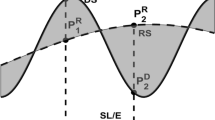Abstract
The use of Stokes’ integral by the remove-compute-restore technique is the most common way to determine the geoid today. The method includes direct, primary and secondary indirect topographic effects. This article is mainly devoted to the secondary indirect topographic effect (SITE), which reaches the extreme values of 265 mGal and −0.6 mGal for the uncompensated and Helmert condensation compensated gravity anomalies, respectively. The corresponding effects on the geoid height reach the magnitudes of 328 m and −0.5 m, respectively. Here we emphasize that the SITE is a direct effect, needed in a rigorous gravity anomaly. For surface as well as for classical gravity anomalies, located at the geoid, the SITE can be interpreted as a shift in the normal gravity along the ellipsoidal normal to the point where the normal potential equals the topographically reduced geopotential at the computation point. We show that it may yield a bias of the order of −0.9 m in the Himalayas if not properly considered in the surface anomaly. This bias does not change when using a topographic compensation model, e.g., by Helmert condensation of the topography. The problem is avoided when using the no-topography gravity anomaly with or without compensation.
Similar content being viewed by others
References
Heiskanen W.A. and Moritz H., 1967. Physical Geodesy. W.H. Freeman and Co., San Francisco and London.
Hinze W.J., Aiken C., Brozena J., Coakley B., Dater D., Flanagan G., Forsberg R., Hildenbrand T., Keller G.R., Kellogg J., Kucks R., Li X., Mainville A., Morin R., Pilkington M., Plouff D., Ravat D., Roman D., Urrutia-Fucugauchi J., Véronneau M., Webring M. and Wineste D., 2005. New standards for reducing gravity data: The North American gravity database. Geophysics, 70, J25–J32.
Hofmann-Wellenhof B. and Moritz H., 2005. Physical Geodesy. Springer-Verlag, New York.
Martinec Z., Matyska C., Grafarend E.W. and Vanícek P., 1993. On Helmert’s 2nd condensation method. Manuscr. Geod., 18, 417–421.
Moritz H., 1990. The Figure of the Earth. Wichmann, Karlsruhe, Germany.
Pavlis N.K., Factor J.K. and Holmes S.A., 2007. Terrain-related gravimetric quantities computed for the next EGM. In: Kiliçoglu A. and Forsberg R. (Eds), Gravity Field of the Earth. Proceedings of the 1st International Symposium of the International Gravity Field Service “Gravity field of the Earth”. Harita Dergisi, Special Issue 18, General Command of Mapping, Istanbul, Turkey, 318–323 (http://earth-info.nga.mil/GandG/wgs84/gravitymod/new_egm/EGM08_papers /NPavlis%26al_S8_Revised111606.pdf).
Sanso F. and Sideris M. (Eds), 2013. Geoid Determination- Theory and Methods. Lecture Notes in Earth System Sciences, Springer-Verlag, Heidelberg, Germany.
Sideris M. and Forsberg R., 1990. Review of geoid prediction methods in mountainous regions. In: Rapp. R.H. and Sanso F. (Eds), Determination of the Geoid. International Association of Geodesy Symposia, 106, Springer-Verlag, New York, 51–62.
Sjöberg L.E., 1977. On the errors of spherical harmonic developments of gravity at the surface of the earth. Report 257. Department of Geodetic Sciences, The Ohio State University, Columbus, OH.
Sjöberg L.E., 1994. The total terrain effect in the modified Stokes formula. In: Sunkel H. and Marson I. (Eds), Gravity and Geoid. International Association of Geodesy Symposia, 113, Springer-Verlag, Heidelberg, Germany, 616–623.
Sjöberg L.E., 1996. On the error of analytical continuation in physical geodesy. J. Geodesy, 70, 724–730.
Sjöberg L.E., 2000. Topographic effects by the Stokes-Helmert method of geoid and quasi-geoid determinations. J. Geodesy, 74, 255–268.
Sjöberg L.E., 2003. A computational scheme to model the geoid by the modified Stokes’ formula. J. Geodesy, 77, 459–464.
Sjöberg L.E., 2007. The topographic bias by analytical continuation in physical geodesy. J. Geodesy, 81, 345–350.
Sjöberg L.E., 2009a. The terrain correction in gravimetric geoid determination- is it needed- Geophys. J. Int., 176, 14–18.
Sjöberg L.E., 2009b. On the topographic bias in geoid determination by the external gravity field. J. Geodesy, 83, 967–972.
Sjöberg L.E., 2009c. Solving Vening Meinesz-Moritz inverse problem in isostasy. Geophys. J. Int., 179, 1527–1536.
Sjöberg L.E., 2012. The geoid-to-quasigeoid difference using an arbitrary gravity reduction model. Stud. Geophys. Geod., 56, 929–933.
Sjöberg L.E., 2013. On the isostatic gravity anomaly and disturbance and their applications to Vening Meinesz-Moritz inverse problem of isostasy. Geophys. J. Int., 193, 1277–1282.
Vajda P., Vaníček P., Novák P., Tenzer R. and Ellmann A., 2007. Secondary indirect effects in gravity anomaly data inversion or interpretation. J. Geophys. Res., 112, B06411.
Vaníček P., Tenzer R., Sjöberg L.E., Martinec Z. and Featherstone W.E., 2004. New views of the spherical Bouguer gravity anomaly. Geophys. J. Int., 159, 460–472.
Author information
Authors and Affiliations
Corresponding author
Rights and permissions
About this article
Cite this article
Sjöberg, L.E. The secondary indirect topographic effect in physical geodesy. Stud Geophys Geod 59, 173–187 (2015). https://doi.org/10.1007/s11200-014-1003-2
Received:
Revised:
Accepted:
Published:
Issue Date:
DOI: https://doi.org/10.1007/s11200-014-1003-2




